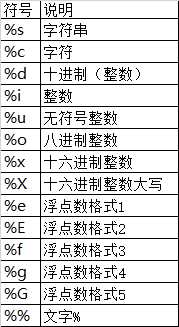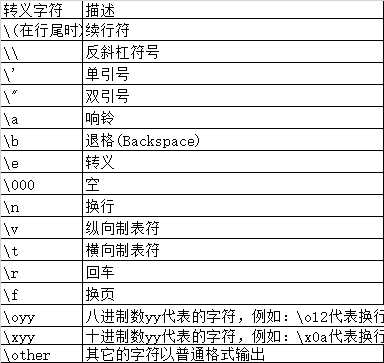标签:根据 技术 mic 用法 参数 div sel 版本 nts
转自fat39原文 python基础_格式化输出(%用法和format用法)
%o —— oct 八进制
%d —— dec 十进制
%x —— hex 十六进制
1 >>> print(‘%o‘ % 20) 2 24 3 >>> print(‘%d‘ % 20) 4 20 5 >>> print(‘%x‘ % 20) 6 14
2、浮点数输出
(1)格式化输出
%f ——保留小数点后面六位有效数字
%.3f,保留3位小数位
%e ——保留小数点后面六位有效数字,指数形式输出
%.3e,保留3位小数位,使用科学计数法
%g ——在保证六位有效数字的前提下,使用小数方式,否则使用科学计数法
%.3g,保留3位有效数字,使用小数或科学计数法
1 >>> print(‘%f‘ % 1.11) # 默认保留6位小数 2 1.110000 3 >>> print(‘%.1f‘ % 1.11) # 取1位小数 4 1.1 5 >>> print(‘%e‘ % 1.11) # 默认6位小数,用科学计数法 6 1.110000e+00 7 >>> print(‘%.3e‘ % 1.11) # 取3位小数,用科学计数法 8 1.110e+00 9 >>> print(‘%g‘ % 1111.1111) # 默认6位有效数字 10 1111.11 11 >>> print(‘%.7g‘ % 1111.1111) # 取7位有效数字 12 1111.111 13 >>> print(‘%.2g‘ % 1111.1111) # 取2位有效数字,自动转换为科学计数法 14 1.1e+03
(2)内置round()
round(number[, ndigits])
参数:
number - 这是一个数字表达式。
ndigits - 表示从小数点到最后四舍五入的位数。默认值为0。
返回值
该方法返回x的小数点舍入为n位数后的值。
round()函数只有一个参数,不指定位数的时候,返回一个整数,而且是最靠近的整数,类似于四舍五入,当指定取舍的小数点位数的时候,一般情况也是使用四舍五入的规则,但是碰到.5的情况时,如果要取舍的位数前的小数是奇数,则直接舍弃,如果是偶数则向上取舍。
注:“.5”这个是一个“坑”,且python2和python3出来的接口有时候是不一样的,尽量避免使用round()函数吧
1 >>> round(1.1125) # 四舍五入,不指定位数,取整 2 1 3 >>> round(1.1135,3) # 取3位小数,由于3为奇数,则向下“舍” 4 1.113 5 >>> round(1.1125,3) # 取3位小数,由于2为偶数,则向上“入” 6 1.113 7 >>> round(1.5) # 无法理解,查阅一些资料是说python会对数据进行截断,没有深究 8 2 9 >>> round(2.5) # 无法理解 10 2 11 >>> round(1.675,2) # 无法理解 12 1.68 13 >>> round(2.675,2) # 无法理解 14 2.67 15 >>>
3、字符串输出
%s
%10s——右对齐,占位符10位
%-10s——左对齐,占位符10位
%.2s——截取2位字符串
%10.2s——10位占位符,截取两位字符串
1 >>> print(‘%s‘ % ‘hello world‘) # 字符串输出 2 hello world 3 >>> print(‘%20s‘ % ‘hello world‘) # 右对齐,取20位,不够则补位 4 hello world 5 >>> print(‘%-20s‘ % ‘hello world‘) # 左对齐,取20位,不够则补位 6 hello world 7 >>> print(‘%.2s‘ % ‘hello world‘) # 取2位 8 he 9 >>> print(‘%10.2s‘ % ‘hello world‘) # 右对齐,取2位 10 he 11 >>> print(‘%-10.2s‘ % ‘hello world‘) # 左对齐,取2位 12 he
4、其他
(1)字符串格式代码

(2)常用转义字符

format用法
相对基本格式化输出采用‘%’的方法,format()功能更强大,该函数把字符串当成一个模板,通过传入的参数进行格式化,并且使用大括号‘{}’作为特殊字符代替‘%’
位置匹配
(1)不带编号,即“{}”
(2)带数字编号,可调换顺序,即“{1}”、“{2}”
(3)带关键字,即“{a}”、“{tom}”
1 >>> print(‘{} {}‘.format(‘hello‘,‘world‘)) # 不带字段
2 hello world
3 >>> print(‘{0} {1}‘.format(‘hello‘,‘world‘)) # 带数字编号
4 hello world
5 >>> print(‘{0} {1} {0}‘.format(‘hello‘,‘world‘)) # 打乱顺序
6 hello world hello
7 >>> print(‘{1} {1} {0}‘.format(‘hello‘,‘world‘))
8 world world hello
9 >>> print(‘{a} {tom} {a}‘.format(tom=‘hello‘,a=‘world‘)) # 带关键字
10 world hello world
>>> ‘{0}, {1}, {2}‘.format(‘a‘, ‘b‘, ‘c‘)
‘a, b, c‘
>>> ‘{}, {}, {}‘.format(‘a‘, ‘b‘, ‘c‘) # 3.1+版本支持
‘a, b, c‘
>>> ‘{2}, {1}, {0}‘.format(‘a‘, ‘b‘, ‘c‘)
‘c, b, a‘
>>> ‘{2}, {1}, {0}‘.format(*‘abc‘) # 可打乱顺序
‘c, b, a‘
>>> ‘{0}{1}{0}‘.format(‘abra‘, ‘cad‘) # 可重复
‘abracadabra‘
>>> ‘Coordinates: {latitude}, {longitude}‘.format(latitude=‘37.24N‘, longitude=‘-115.81W‘)
‘Coordinates: 37.24N, -115.81W‘
>>> coord = {‘latitude‘: ‘37.24N‘, ‘longitude‘: ‘-115.81W‘}
>>> ‘Coordinates: {latitude}, {longitude}‘.format(**coord)
‘Coordinates: 37.24N, -115.81W‘
>>> c = 3-5j
>>> (‘The complex number {0} is formed from the real part {0.real} ‘
... ‘and the imaginary part {0.imag}.‘).format(c)
‘The complex number (3-5j) is formed from the real part 3.0 and the imaginary part -5.0.‘
>>> class Point:
... def __init__(self, x, y):
... self.x, self.y = x, y
... def __str__(self):
... return ‘Point({self.x}, {self.y})‘.format(self=self)
...
>>> str(Point(4, 2))
‘Point(4, 2)‘
>>>
>>> coord = (3, 5)
>>> ‘X: {0[0]}; Y: {0[1]}‘.format(coord)
‘X: 3; Y: 5‘
>>> a = {‘a‘: ‘test_a‘, ‘b‘: ‘test_b‘}
>>> ‘X: {0[a]}; Y: {0[b]}‘.format(a)
‘X: test_a; Y: test_b‘
格式转换
‘b‘ - 二进制。将数字以2为基数进行输出。
‘c‘ - 字符。在打印之前将整数转换成对应的Unicode字符串。
‘d‘ - 十进制整数。将数字以10为基数进行输出。
‘o‘ - 八进制。将数字以8为基数进行输出。
‘x‘ - 十六进制。将数字以16为基数进行输出,9以上的位数用小写字母。
‘e‘ - 幂符号。用科学计数法打印数字。用‘e‘表示幂。
‘g‘ - 一般格式。将数值以fixed-point格式输出。当数值特别大的时候,用幂形式打印。
‘n‘ - 数字。当值为整数时和‘d‘相同,值为浮点数时和‘g‘相同。不同的是它会根据区域设置插入数字分隔符。
‘%‘ - 百分数。将数值乘以100然后以fixed-point(‘f‘)格式打印,值后面会有一个百分号。
1 >>> print(‘{0:b}‘.format(3))
2 11
3 >>> print(‘{:c}‘.format(20))
4
5 >>> print(‘{:d}‘.format(20))
6 20
7 >>> print(‘{:o}‘.format(20))
8 24
9 >>> print(‘{:x}‘.format(20))
10 14
11 >>> print(‘{:e}‘.format(20))
12 2.000000e+01
13 >>> print(‘{:g}‘.format(20.1))
14 20.1
15 >>> print(‘{:f}‘.format(20))
16 20.000000
17 >>> print(‘{:n}‘.format(20))
18 20
19 >>> print(‘{:%}‘.format(20))
20 2000.000000%
21 >>>
进阶用法
进制转换
>>> # format also supports binary numbers
>>> "int: {0:d}; hex: {0:x}; oct: {0:o}; bin: {0:b}".format(42)
‘int: 42; hex: 2a; oct: 52; bin: 101010‘
>>> # with 0x, 0o, or 0b as prefix:
>>> "int: {0:d}; hex: {0:#x}; oct: {0:#o}; bin: {0:#b}".format(42) # 在前面加“#”,则带进
左中右对齐及位数补全
(1)< (默认)左对齐、> 右对齐、^ 中间对齐、= (只用于数字)在小数点后进行补齐
(2)取位数“{:4s}”、"{:.2f}"等
>>> print(‘{} and {}‘.format(‘hello‘,‘world‘)) # 默认左对齐
hello and world
>>> print(‘{:10s} and {:>10s}‘.format(‘hello‘,‘world‘)) # 取10位左对齐,取10位右对齐
hello and world
>>> print(‘{:^10s} and {:^10s}‘.format(‘hello‘,‘world‘)) # 取10位中间对齐
hello and world
>>> print(‘{} is {:.2f}‘.format(1.123,1.123)) # 取2位小数
1.123 is 1.12
>>> print(‘{0} is {0:>10.2f}‘.format(1.123)) # 取2位小数,右对齐,取10位
1.123 is 1.12
>>> ‘{:<30}‘.format(‘left aligned‘) # 左对齐
‘left aligned ‘
>>> ‘{:>30}‘.format(‘right aligned‘) # 右对齐
‘ right aligned‘
>>> ‘{:^30}‘.format(‘centered‘) # 中间对齐
‘ centered ‘
>>> ‘{:*^30}‘.format(‘centered‘) # 使用“*”填充
‘***********centered***********‘
>>>‘{:0=30}‘.format(11) # 还有“=”只能应用于数字,这种方法可用“>”代替
‘000000000000000000000000000011‘
正负符号显示
>>> ‘{:+f}; {:+f}‘.format(3.14, -3.14) # 总是显示符号
‘+3.140000; -3.140000‘
>>> ‘{: f}; {: f}‘.format(3.14, -3.14) # 若是+数,则在前面留空格
‘ 3.140000; -3.140000‘
>>> ‘{:-f}; {:-f}‘.format(3.14, -3.14) # -数时显示-,与‘{:f}; {:f}‘一致
‘3.140000; -3.140000‘
百分数%
>>> points = 19
>>> total = 22
>>> ‘Correct answers: {:.2%}‘.format(points/total)
‘Correct answers: 86.36%‘
时间
>>> import datetime
>>> d = datetime.datetime(2010, 7, 4, 12, 15, 58)
>>> ‘{:%Y-%m-%d %H:%M:%S}‘.format(d)
‘2010-07-04 12:15:58‘
逗号","分隔金钱,没以前进位
>>> ‘{:,}‘.format(1234567890)
‘1,234,567,890‘
占位符嵌套
>>> for align, text in zip(‘<^>‘, [‘left‘, ‘center‘, ‘right‘]):
... ‘{0:{fill}{align}16}‘.format(text, fill=align, align=align)
...
‘left<<<<<<<<<<<<‘
‘^^^^^center^^^^^‘
‘>>>>>>>>>>>right‘
>>>
>>> octets = [192, 168, 0, 1]
>>> ‘{:02X}{:02X}{:02X}{:02X}‘.format(*octets)
‘C0A80001‘
>>> int(_, 16) # 官方文档给出来的,无法在IDLE复现
3232235521
>>>
>>> width = 5
>>> for num in range(5,12):
... for base in ‘dXob‘:
... print(‘{0:{width}{base}}‘.format(num, base=base, width=width), end=‘ ‘)
... print()
...
5 5 5 101
6 6 6 110
7 7 7 111
8 8 10 1000
9 9 11 1001
10 A 12 1010
11 B 13 1011
占位符%s和%r
"""
replacement_field ::= "{" [field_name] ["!" conversion] [":" format_spec] "}"
conversion ::= "r" | "s" | "a"
这里只有三个转换符号,用"!"开头。
"!r"对应 repr();"!s"对应 str(); "!a"对应ascii()。
"""
>>> "repr() shows quotes: {!r}; str() doesn‘t: {!s}".format(‘test1‘, ‘test2‘)
"repr() shows quotes: ‘test1‘; str() doesn‘t: test2" # 输出结果是一个带引号,一个不带# a.format(b)
>>> "{0} {1}".format("hello","world")
‘hello world‘
# f"xxxx"
# 可在字符串前加f以达到格式化的目的,在{}里加入对象,此为format的另一种形式:
>>> a = "hello"
>>> b = "world"
>>> f"{a} {b}"
‘hello world‘
name = ‘jack‘
age = 18
sex = ‘man‘
job = "IT"
salary = 9999.99
print(f‘my name is {name.capitalize()}.‘)
print(f‘I am {age:*^10} years old.‘)
print(f‘I am a {sex}‘)
print(f‘My salary is {salary:10.3f}‘)
# 结果
my name is Jack.
I am ****18**** years old.
I am a man
My salary is 9999.990
标签:根据 技术 mic 用法 参数 div sel 版本 nts
原文地址:https://www.cnblogs.com/arxive/p/11148882.html